Pruning and thinning eucalyptus - Stringybark eucalypt silviculture
Dean Satchell, New Zealand Tree Grower November 2006.
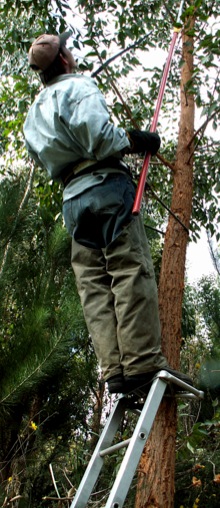
Silviculture of eucalypts for solid-timber requires some understanding of the tree and the timber. That is, a level of skill and knowledge guiding intuition. One wrong cut, or even simple neglect, can ruin a tree. So where can things go wrong? I would have to say timing of maintenance pruning and having suitable equipment are the two crucial areas.
Pruning stringybarks is faster per tree than radiata, and the timber is worth more at the end. So wheres the problem? I believe the biggest issue influencing value and returns is the quality and spacing of final crop trees.
Stocking
Firstly lets look at the area of most concern to me, stocking, and how that relates to silviculture. How many seedlings do we plant, do we need to think about this or just follow radiata regimes of around 1000 sph?
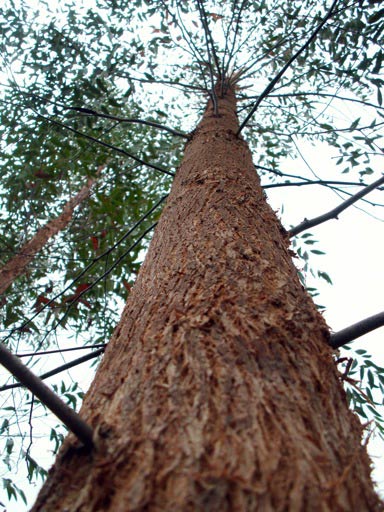
At a high stocking of 2000 stems per hectare we get real selection from a typical unimproved Australian seed line, allowing us to keep just the biggest and straightest trees and without too many gaps in the canopy. At this stocking, branch size is kept to a minimum and upward growth is encouraged. Be aware that timely repeated thinning operations are essential for subsequent girth, and also to avoid excessive upward growth which would lead to tall skinny trees subject to toppling. So is the cost of higher initial stocking compensated for by the higher yield of better quality logs, and is the higher frequency of thinning operations compensated for by lower pruning costs?
Heres another option. By planting trees close within the row (I have found 1.5m is the optimum spacing) a lower initial stocking still allows for good selection. That is, at 7m between rows the initial stocking is only 950/ha, but because selection and rejection takes place only within the row, and in two dimensions, the whole process of selecting crop trees is simpler and more effective. Eucalypts are very happy to be this close initially; and the otherwise complex three dimensional problem of progressively thinning evenly spaced trees down to 250/ha without leaving big gaps in the forest canopy is simplified.
With eucalypts straight trees mean valuable logs. Any wobbles in the trunk mean lower recovery and lower quality when milled. This is because of such issues as compression wood in the core, radial vs tangental shrinkage and a gradient of compression and tension in the trunk. What makes our eucalypts grow wonky? Firstly, high fertility can give them the "speed wobbles", even in fairly sheltered valleys. Finding the optimum fertility and selecting the right species can be a bit hit-and-miss without experience. Genetics is also at play, both at a species level (E.pilularis and E.agglomerata are the worst) and within a seedlot. Again, lots of trees gives lots of selection.
Timely maintenance
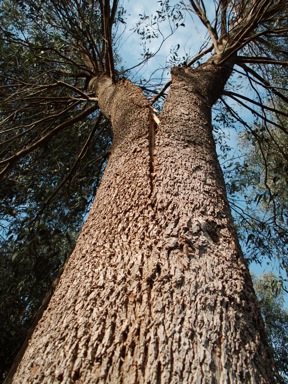
Double leaders, which are most likely a genetic response to environmental factors such as wind and pests, can cause serious form problems if not dealt with in a timely manner. Also wind, or pests such as cicadas and possums, can cause breakage of the leader, with a side branch then taking over as leader, often resulting in poorer form.
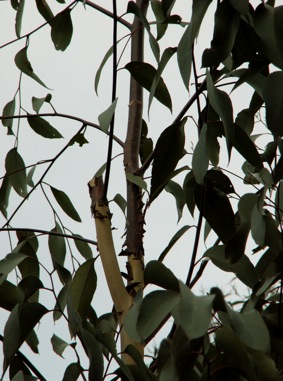
Double leaders must have attention, and I insist the sooner the better. Form is dramatically improved if one of these leaders is removed while still young, because the remaining leader responds by straightening. This simple practice in itself can improve the selection of crop trees dramatically. Simple because there are good pole pruners out there, but not so simple in application because of timing. Every tree in the block needs attention, but how often? I believe that each tree needs an annual visit for the first 5 years. It won't necessarily need attention each year, but catching double leaders on those that do is essential for success. Removing a double-leader that is the thickness of your little finger will improve form more than leaving it until it is thumb thickness. Okay maybe thats a bit fussy but where is the compromise? Leave it too long and form is seriously compromised. Its always about cost vs the improvement in harvest revenue, and such management decisions are not an easy skill to master. While I'm looking for double leaders I also cut back dominant branches which keeps them small for the next operation, lift pruning.
Pruning
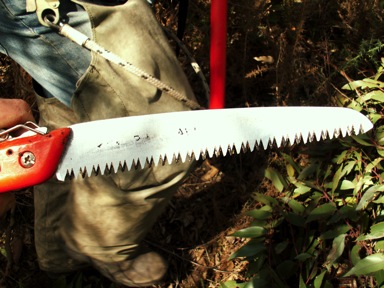
When it comes to the next mission, the real pruning lifts, radiata loppers although acceptable, can be awkward due to both the narrow crotch angles and the potential for bark separation and crushing damage to the pruned collar. Hand-saws give a nice cut, and modern pull-saw blades are very efficient and easy to use. Still hard work though, and careful undercuts are required on bigger branches to avoid bark stripping off down the trunk when it falls. By carefully observing OSH rules lightweight top-handled chainsaws are the tool of choice for many eucalypt pruners that get behind on maintenance. One cut, and fast. However in my opinion if a chainsaw is needed its way too late for quality timber. Keep the branch diameters small- this is more important than DOS.
Another question is whether the small loose dead branches should be removed thus allowing the socket to callous immediately, or left to be shed by the tree. I am not aware of any research on this, but I prefer to pull them out rather than cut them off or leave them to shed by themselves.
Siting
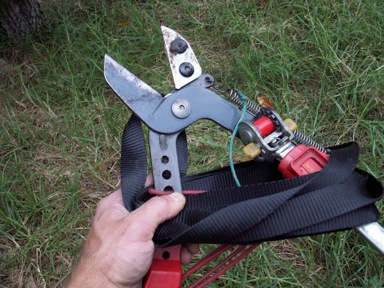
Siting requires local knowledge. Stringybarks being in the Monocalyptus sub-genus, don't like poor draining soils, and are similar to radiata in this requirement. Eucalypts within the sub-genus Symphyomyrtus are usually more adaptable to poorer draining soils, but are more susceptable to pests. Fertility has a huge influence on growth rates of eucalypts. They don't need much, but not enough and they don't grow. Phosphate probably isn't as important as nitrogen; however phosphate deficient soils don't support productive nitrogen-fixing legumes such as clover as a rule. Gorse is a lazy nitrogen fixer and is slow to enrich the soil. Planting in pine cutover seems to work well, as does improved pastures. Stringybarks are frost intolerant as young trees, so are best sited in coastal areas or hillsides above the frost line. They seem to handle wind okay, but as with radiata optimum conditions include some shelter.
Rotation
Presently unpruned Eucalyptus saligna (Sydney Blue Gum) is sawn in Northland down to a small end diameter of 35-40cm. So what is the target log size for stringybarks, with their vastly superior timber? I believe this should be decided at the start, because final crop spacing combined with the rotation length gives you the target diameter. The problem is that we don't really know how sawmill technology and market demand will influence future demand for smaller logs. My gut feeling is that well pruned trees which yield straight small-diameter logs will be in high demand, allowing for final crop stocking of as many as 400-600 stems per hectare which may become suitable for harvest in 20 year rotations.
Selecting for fast growth and straight stems is the objective and I would argue that presently the best way of achieving this is with high initial stocking. I am not aware of any work being undertaken to improve the genetic resource of solid-timber eucalypt species in New Zealand, which to me is a real shame, and perhaps the number one constraint to establishing a commercial-scale industry.
Dean Satchell, Sustainable Forest Solutions, is based in Kerikeri and manages eucalypt plantations in Northland.

 Farm Forestry New Zealand
Farm Forestry New Zealand

